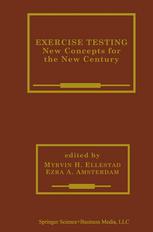

Most ebook files are in PDF format, so you can easily read them using various software such as Foxit Reader or directly on the Google Chrome browser.
Some ebook files are released by publishers in other formats such as .awz, .mobi, .epub, .fb2, etc. You may need to install specific software to read these formats on mobile/PC, such as Calibre.
Please read the tutorial at this link: https://ebookbell.com/faq
We offer FREE conversion to the popular formats you request; however, this may take some time. Therefore, right after payment, please email us, and we will try to provide the service as quickly as possible.
For some exceptional file formats or broken links (if any), please refrain from opening any disputes. Instead, email us first, and we will try to assist within a maximum of 6 hours.
EbookBell Team

5.0
28 reviewsSince it was introduced less than 100 years ago, analysis of the circulatory response to exercise as a measure of cardiac function has undergone remarkable development. Most recently this approach has incorporated the burgeoning technology of the last half of the 20th century to meet the physiological and diagnostic needs of scientist and clinicians. The ease of administration, economy and abundant data that characterize exercise testing for its relative staying power as the most frequently utilized noninvasive method of cardiovascular evaluation. The basic modalities of exercise electrocardiography of treadmill and bicycle have been extended by noninvasive cardiac imaging techniques, including scintigraphy and echocardiography, that have provided new insights in myocardial function during exertion and pharmacologic stress. At the same time, traditional exercise electrocardiography has also been refined by innovations that have broadened its applications.
Exercise Testing: Current Concepts and Recent Advances affords the reader a state-of-the-art presentation of the diverse and expanding methods of exercise testing and their roles in patient management. The contributors to this volume include individuals who have made seminal contributions to the field during the last several decades. Indeed, it is legitimate to designate this group as a `Who's Who of Exercise Testing'. It is our hope that this book will enhance the reader's understanding of contemporary methods of exercise testing, as well as provide a glimpse into future directions of this science, that this knowledge is applied to optimal diagnosis and management of our patients.